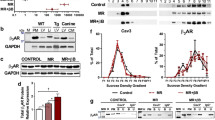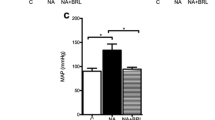Abstract
As adrenergic-induced cardiac dilatation is associated with cardiomyocyte cell death, whether cessation of excessive adrenergic effects can achieve complete reverse chamber remodelling in established cardiac dilatation and pump dysfunction has been questioned. We assessed whether following the development of cardiac dilatation and pump dysfunction subsequent to 6 months of daily β-adrenergic receptor agonist administration (isoproterenol [ISO] at 0.01 mg/kg daily) to rats, withdrawal of ISO administration for a further 4 months (ISO + recovery) reverses the adverse effects on the heart. Chronic ISO administration and the withdrawal of ISO administration were associated with changes in cardiomyocyte apoptosis, but not myocardial necrosis (pathological score). After 6 months of ISO administration, left ventricular (LV) end diastolic and systolic diameters, and the volume intercept of the LV diastolic pressure–volume relationship (LV V 0), were markedly increased and LV endocardial fractional shortening (FSend), LV end systolic chamber (slope of the systolic pressure–volume relationship-Ees) and myocardial (slope of the systolic stress–strain relationship-En) contractility were substantially decreased. Chronic ISO administration produced a 2.5 times increase in LV V 0 (ISO = 0.40 ± 0.04 vs. saline = 0.16 ± 0.01, P < 0.001). Following a 6-month period of ISO administration and a subsequent withdrawal period for a further 4 months, LV chamber diameters, LV V 0 (ISO + recovery = 0.21 ± 0.02 vs. saline = 0.23 ± 0.02, P < 0.001), FSend, LV Ees and LV En were all noted to be similar to control rats. The proportion of ISO + recovery rats with LV chamber diameters, LV V 0, FSend, LV Ees and LV En values above or below the 95% confidence interval for the saline + recovery rats was similar to the proportion of saline + recovery rats above or below their own 95% confidence intervals. In conclusion, even in the presence of adrenergic-induced cardiomyocyte apoptosis, marked cardiac dilatation and pump dysfunction produced by chronic β-adrenergic receptor activation can be completely reversed by withdrawal of the excessive adrenergic stimulus.





Similar content being viewed by others
References
Angert D, Berretta RM, Kubo H, Zhang H, Chen X, Wang W, Ogorek B, Barbe M, Houser SR (2011) Repair of the injured adult heart involves new myocytes potentially derived from resident cardiac stem cells. Circ Res 108:1226–1237. doi:10.1161/CIRCRESAHA.110.239046
Argawala S, Kalil RE (1998) Axotomy-induced neuronal death and reactive astrogliosis in the lateral geniculate nucleus following a lesion of the visual cortex in the rat. J Comp Neurol 392:252–263. doi:10.1002/(SICI)1096-9861(19980309)392:2<252:AID-CNE7>3.0.CO;2-1
Barbone A, Oz MC, Burkhoff D, Holmes JW (2001) Normalized diastolic properties after left ventricular assist result from reverse remodeling of chamber geometry. Circulation 104:I229–I232. doi:10.1161/hc37t1.094914
Bello D, Shah DJ, Faragh GM, Di Luzio S, Parker M, Johnson MR, Cottss WG, Klocker FJ, Bonow RO, Judd RM, Gheorghiade M, Kim RJ (2003) Gadolinium cardiovascular magnetic resonance predicts reversible myocardial dysfunction and remodeling in patients with heart failure undergoing beta-blocker therapy. Circulation 108:1945–1953. doi:10.1161/01.CIR.0000095029.57483.60
Bristow MR, Gilbert EM, Abraham WT, Adams KF, Fowler MB, Hershberger RE, Kubo SH, Narahara KA, Ingersoll H, Krueger S, Young S, Shusterman N (1996) Carvedilol produces dose-related improvements in left ventricular function and survival in subjects with chronic heart failure. MOCHA Investigators. Circulation 94:2807–2816
Capomolla S, Febo O, Gnemmi M, Riccardi G, Opasich C, Caporotondi A, Mortara A, Pinna GD, Cobelli F (2000) Beta-blockade therapy in chronic heart failure: diastolic function and mitral regurgitation improvement by carvedilol. Am Heart J 139:596–608. doi:10.1016/S0002-8709(00)90036-X
Chan V, Fenning A (2011) Chronic beta-adrenoceptor antagonist treatment controls cardiovascular remodelling in heart failure in the ageing spontaneously hypertensive rat: metoprolol and cardiovascular changes in SHR. J Cardiovasc Pharmacol. doi:10.1097/FJC.0b013e3182283c78 (online before print)
Chen G, Zhou X, Florea S, Qian J, Cai W, Zhang Z, Fan G-C, Lorenz j, Lorenz j, Hajjar RJ, Kranias EG (2010) Expression of active protein phosphatase 1 inhibitor-1 attenuates chronic beta-agonist-induced cardiac apoptosis. Basic Res Cardiol 105:573–581. doi:10.1007/s00395-010-0106-3
Cohn JN, Ferrari R, Sharpe N (2000) Cardiac remodeling-concepts and clinical implications: a consensus paper from an international forum on cardiac remodeling. On behalf of an International Forum on Cardiac Remodeling. J Am Coll Cardiol 35:569–582. doi:10.1016/S35-1097(99)00630-0
Doughty RN, Whalley GA, Gamble G, MacMahon S, Sharpe N (1997) Left ventricular remodeling with carvedilol in patients with congestive heart failure due to ischemic heart disease. Australia–New Zealand Heart Failure Research Collaborative Group. J Am Coll Cardiol 29:1060–1066. doi:10.1016/S0735-1097(97)00012-0
Egred M, Shaw S, Mohammad B, Waitt P, Rodrigues E (2005) Under-use of beta-blockers in patients with ischaemic heart disease and concomitant chronic obstructive pulmonary disease. QJM 98:493–497. doi:10.1093/qjmed/hci080
Fowler MB, Lottes SR, Nelson JJ, Lukas MA, Gilbert EM, Greenberg B, Massie BM, Abraham WT, Franciosa JA (2007) Beta-blocker dosing in community-based treatment of heart failure. Am Heart J 153:1029–1036. doi:10.1016/j.ahj.2007.03.010
Garlie JB, Hamid T, Gu Y, Ismahil MA, Chandrasekar B, Prabhu SD (2011). Tumour necrosis factor receptor 2 signaling limits β-adrenergic receptor-mediated cardiac hypertrophy in vivo. Basic Res Cardiol. doi:10.1007/s00395-011-0196-6 (E-pub ahead of print)
Gan RT, Li WM, Xiu CH, Shen JX, Wang X, Wu S, Kong YH (2007) Chronic blocking of beta 3-adrenoceptor ameliorates cardiac function in rat model of heart failure. Chin Med J (Engl) 120:2250–2255
Groenning BA, Nilsson JC, Sondergaard L, Fritz-Hansen T, Larsson HB, Hildebrandt PR (2000) Antiremodeling effects on the left ventricle during beta-blockade with metoprolol in the treatment of chronic heart failure. J Am Coll Cardiol 36:2072–2080. doi:10.1016/S0735-1097(00)01006-8
Hall SA, Cigarroa CG, Marcoux L, Risser RC, Grayburn PA, Eichhorn EJ (1995) Time course of improvement in left ventricular function, mass and geometry in patients with congestive heart failure treated with beta-adrenergic blockade. J Am Coll Cardiol 25:1154–1161. doi:10.1016/0735-1097(94)00543-Y
Heather LC, Catchpole AF, Stuckey DJ, Cole MA, Carr CA, Clarke K (2009) Isoproterenol induces in vivo functional and metabolic abnormalities; similar to those found in the infarcted rat heart. J Physiol Pharm 60:31–39
Hu K, Gaudron P, Ertl G (1998) Long-term effects of beta-adrenergic blocking agent treatment on hemodynamic function and left ventricular remodeling in rats with experimental myocardial infarction: importance of timing of treatment and infarct size. J Am Coll Cardiol 31:692–700. doi:10.1016/S0735-1097(97)00527-5
Hunt SA, Abraham WT, Chin MH, Feldman AM, Francis GS, Ganiats TG, Jessup M, Konstam MA, Mancini DM, Michl K, Oates JA, Rahko PS, Silver MA, Warner Stevenson L, Yancy CW (2009) 2009 Focused update incorporated into the ACC/AHA 2005 guidelines for the diagnosis and management of heart failure in adults. Circulation 119:e391–e479. doi:10.1161/CIRCULATIONAHA.109.192065
Kluger J, Cody RJ, Laragh JH (1982) The contributions of sympathetic tone and the renin-angiotensin system to severe chronic congestive heart failure: response to specific inhibitors (prazosin and captopril). Am J Cardiol 49:1667–1674. doi:10.1016/0002-9149(82)90244-2
Lee DI, Vahebi S, Gabriele C, Tocchetti CG, Barouch LA, Solaro RJ, Takimoto E, Kass DA (2010) PDE5A suppression of acute β-adrenergic activation requires modulation of myocyte beta-3 signaling coupled to PKG-mediated troponin I phosphorylation. Basic Res Cardiol 105:337–347. doi:10.1007/s00395-010-0084-5
Lenzen MJ, Boersma E, Reimer WJ, Balk AH, Komajda M, Swedberg K, Follath F, Jimenez-Navarro M, Simmons ML, Cleland J (2005) Under-utilization of evidence-based drug treatment in patients with heart failure is only partially explained by dissimilarity to patients enrolled in landmark trials: a report from the Euro Heart Survey on Heart Failure. Eur Heart J 26:2706–2713. doi:10.1093/eurheartj/ehi499
Lotze U, Kaepplinger S, Kober A, Richartz B, Gottschild D, Figulla HR (2001) Recovery of the cardiac adrenergic nervous system after long-term beta-blocker therapy in idiopathic dilated cardiomyopathy: assessment by increase in myocardial 123I-metaiodobenzylguanidine uptake. J Nucl Med 42:49–54
Mancini DM, Beniaminovitz A, Levin H, Catanese K, Flannery M, DiTullio M, Savin S, Cordisco ME, Rose E, Oz M (1998) Low incidence of myocardial recovery after left ventricular assist device implantation in patients with chronic heart failure. Circulation 98:2383–2389. doi:10.1161/01.CIR.98.22.2383
Maybaum S, Mancini D, Xydas S, Starling RC, Aaronson K, Pagani FD, Miller LW, Margulies K, McRee S, Frazier OH, Torre-Amione G, For the LVAD Working Group (2007) Cardiac improvement during mechanical circulatory support. A prospective multicenter study of the LVAD working group. Circulation 115:2497–2505. doi:10.1161/CIRCULATIONAHA.106.633180
MacIver DH (2010) Is remodeling the dominant compensatory mechanism in both chronic heart failure with preserved and reduced left ventricular ejection fraction. Basic Res Cardiol 105:227–234. doi:10.1007/s00395-009-0063-x
Metra M, Giubbini R, Nodari S, Boldi E, Modena MG, Dei Cas L (2000) Differential effects of beta-blockers in patients with heart failure: a prospective, randomized, double-blind comparison of the long-term effects of metoprolol versus carvedilol. Circulation 102:546–551. doi:10.1161/01.CIR.102.5.546
Norton GR, Woodiwiss AJ, Gaasch WH, Mela T, Chung ES, Aurigemma GP, Meyer TE (2002) Heart failure in pressure overload hypertrophy. The relative roles of ventricular remodeling and myocardial dysfunction. J Am Coll Cardiol 39:664–671. doi:10.1016/S0735-1097(01)01792-2
Osadchii OE, Norton GR, McKechnie R, Deftereos D, Woodiwiss AJ (2007) Cardiac dilatation and pump dysfunction without intrinsic myocardial systolic failure following chronic beta-adrenoreceptor activation. Am J Physiol Heart Circ Physiol 292:H1898–H1905. doi:10.1152/ajpheart.00740.2006
Poole-Wilson PA, Swedberg K, Cleland JG, Di Lenarda A, Hanrath P, Komajda M, Lubsen J, Lutiger B, Metra M, Remme WJ, Torp-Pederson C, Scherhag A, Skene A (2003) Comparison of carvedilol and metoprolol on clinical outcomes in patients with chronic heart failure in the Carvedilol Or Metoprolol European Trial (COMET): randomised controlled trial. Lancet 362:7–13. doi:10.1016/S0140-6736(03)13800-7
Rahko PS (2005) An echocardiographic analysis of the long-term effects of carvedilol on left ventricular remodeling, systolic performance, and ventricular filling patterns in dilated cardiomyopathy. Echocardiography 22:547–554. doi:10.111/j.1540-8175.2005.40057.X
Sahn DJ, De Maria A, Kisslo J, Weyman A (1978) Recommendations regarding quantitation of M-mode echocardiography: results of a survey of echocardiographic measurements. Circulation 58:1072–1083
Takahama H, Asanuma H, Sanada S, Fujita M, Sasaki H, Wakeno M, Kim J, Asakura M, Takashima S, Minamino T, Komamura K, Sugimachi M, Kitakaze M (2101) A histamine H2 receptor blocker ameliorates development of heart failure in dogs independently of β-adrenergic receptor blockade. Basic Res Cardiol 105:787–794. doi:10.1007/s00395-010-0119-y
Teerlink JR, Pfeffer JM, Pfeffer MA (1994) Progressive ventricular remodeling in response to diffuse isoproterenol-induced myocardial necrosis in rats. Circ Res 75:105–113
Vasan RS, Larson MG, Benjamin EJ, Evans JC, Levy D (1997) Left ventricular dilation and the risk of congestive heart failure in people without myocardial infarction. N Engl J Med 336:1350–1355. doi:10.1056/NEJM199705083361903
Veliotes DG, Woodiwiss AJ, Deftereos DA, Gray D, Osadchii O, Norton GR (2005) Aldosterone receptor blockade prevents the transition to cardiac pump dysfunction induced by beta-adrenoreceptor activation. Hypertension 45:914–920. doi:10.1161/01.HYP.0000164567.62172.c5
Waagstein F, Caidahl K, Wallentin I, Bergh CH, Hjalmarson A (1989) Long-term beta-blockade in dilated cardiomyopathy. Effects of short- and long-term metoprolol treatment followed by withdrawal and readministration of metoprolol. Circulation 80:551–563. doi:10.1161/01.CIR.80.3.551
Waagstein F, Stromblad O, Andersson B, Bohm M, Darius M, Delius W, Goss F, Osterziel KJ, Sigmund M, Trenkwalder SP, Wahlqvist I (2003) Increased exercise ejection fraction and reversed remodeling after long-term treatment with metoprolol in congestive heart failure: a randomized, stratified, double-blind, placebo-controlled trial in mild to moderate heart failure due to ischemic or idiopathic dilated cardiomyopathy. Eur J Heart Fail 5:679–691. doi:10.1016/S1388-9842(03)00105-3
Weber KT, Janicki J, Schroff SG, Pick R, Chen RM, Abrahams G, Bashey RI (1988) Collagen remodeling of the pressure-overloaded hypertrophied non-human primate myocardium. Circ Res 62:757–765
Woodiwiss AJ, Tsotetsi OJ, Sprott S, Lancaster EJ, Mela T, Chung ES, Meyer TE, Norton GR (2001) Reduction in myocardial collagen cross-linking parallels left ventricular dilatation in rat models of systolic chamber dysfunction. Circulation 103:155–160. doi:10.1161/01.CIR.103.1.155
Yussman MG, Toyokawa T, Odley A, Lynch RA, Wu G, Colbert MC, Aronow BJ, Lorenz JN, Dorn GW (2002) Mitochondrial death protein Nix is induced in cardiac hypertrophy and triggers apoptotic cardiomyopathy. Nat Med 8:725–730. doi:10.1038/nm719
Acknowledgments
This work was supported by the University Research Council of the University of the Witwatersrand, and the South African National Research Foundation.
Conflict of interest
None.
Author information
Authors and Affiliations
Corresponding author
Rights and permissions
About this article
Cite this article
Booysen, H.L., Norton, G.R., Opie, L.H. et al. Reverse chamber remodelling following adrenergic-induced advanced cardiac dilatation and pump dysfunction. Basic Res Cardiol 107, 238 (2012). https://doi.org/10.1007/s00395-011-0238-0
Received:
Revised:
Accepted:
Published:
DOI: https://doi.org/10.1007/s00395-011-0238-0




